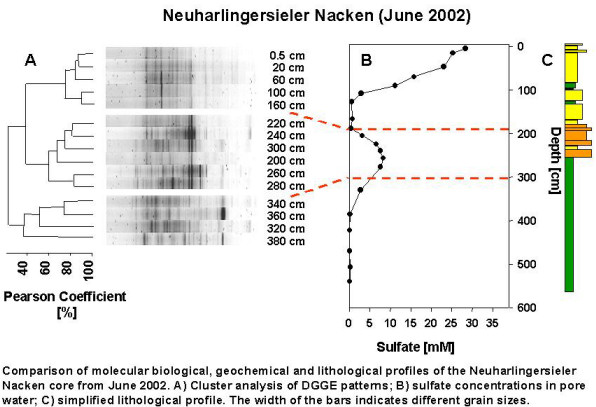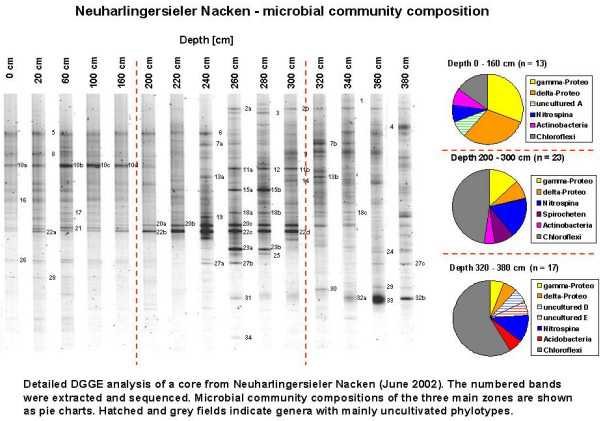
BioGeoChemistry of Tidal Flats
Microbial community compositions in deeper sediments
Microbial communities from the upper 20 cm of Wadden Sea sediments have been investigated repeatedly. However, very little is known about the sediment layers below. To fill this gap of information, we analysed the microbial diversity and activity in a 4.5 meter long sediment core taken on the Neuharlingersieler Nacken in June 2002.
For molecular biological analysis of the microbial communities, the total nucleic acids (DNA) were extracted from the sediment layers in 20 cm depth intervals. The extracted genomic DNA served as a template for the polymerase chain reaction (PCR). Universal bacterial primers were used to specifically amplify a part of the 16S rRNA gene. Amplification products were analysed by denaturing gradient gel electrophoresis (DGGE) using a gradient of 50 to 70 % denaturant in order to detect and compare variations of the microbial community compositions. This technique produces band patterns in an electrophoresis gel. Each band represents one sequence type indicating one bacterial species. These band patterns visualise "fingerprints" of the investigated microbial communities. The similarity of DGGE patterns is displayed in a dendrogram calculated by Pearson correlation and UPGMA. It shows three clusters of community composition. The clusters correspond to the three lithologically different intervals in the core. The upper cluster of samples from 0 to 160 cm belong to the sand-dominated core section. The cluster of samples between 200 and 300 cm depth matches the shell-rich interval and the uppermost part of the mud layer. This corresponds to the interval in which sulfate concentrations in the pore water reach a second maximum at depth. The microbial community present in the deepest mud-rich section of the core (below 320 cm) formed the third cluster.

To get a more detailed view on the investigated microbial communities, DGGE bands of interest were excised and identified by 16S rDNA sequencing. The main genera within the first cluster (0 to 160 cm) of the core are γ- and δ-Proteobacteria. These bacterial groups are widespread in marine habitats. Microbial community composition changed in the deeper sediment zone and was dominated by members of the Chloroflexi group. This group mostly contains so far uncultivated bacteria and is known as a major component of microbial communities from subsurface habitats. In general, the fraction of the not yet cultured microorganisms increased dramatically with depth.
| <<back | All publications
|
More details
|
